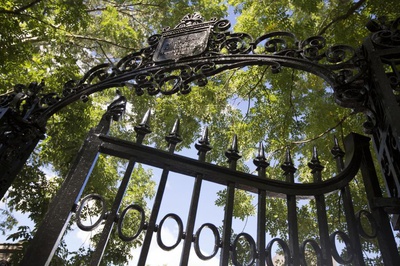
News
Harvard Researchers Develop AI-Driven Framework To Study Social Interactions, A Step Forward for Autism Research

News
Harvard Innovation Labs Announces 25 President’s Innovation Challenge Finalists

News
Graduate Student Council To Vote on Meeting Attendance Policy

News
Pop Hits and Politics: At Yardfest, Students Dance to Bedingfield and a Student Band Condemns Trump

News
Billionaire Investor Gerald Chan Under Scrutiny for Neglect of Historic Harvard Square Theater
The Critical Mass. (Hall)
The top two floors of this historic building should remain first-year housing
Eavesdrop on a tour of Harvard Yard and you might overhear an oddly perky undergrad telling a swarm of tourists that all of the buildings surrounding the Old Yard are freshman dorms—with two-and-a-half exceptions. Come next fall, however, that number may jump to three. The quirky half—better known as Massachusetts Hall—will join University Hall and Harvard Hall and, unfortunately, may cease to house first-year Harvard students.
Following last summer’s transfer of control of Mass. Hall from the Faculty of Arts and Sciences (FAS) to the University’s central administration, this coming September will be the first move-in day in over 80 that freshmen won’t move into the top two floors of Mass. Hall. However, this should not be looked upon as a beneficial consolidation of freshman housing. Discontinuing the long tradition of housing first-year Harvard students in Mass. Hall both undermines the building’s long tradition of housing students and indicates a sad transfer of energy away from the integration of students and administrators.
Mass. Hall—built in 1720—is the oldest standing building at Harvard and the second-oldest standing academic building in the United States (behind the Wren Building at The College of William and Mary). Originally constructed as a dormitory for students, the building was used as housing for soldiers during the siege of Boston in 1775 and 1776 and subsequently used as dormitory, office, and administrative space. In the 1920s it was converted back to a dormitory, and in 1939, the Harvard president’s office moved from University Hall into the bottom floors of Mass. Hall. Parts of the top two floors of the building, however, are still used to house around 20 first-year college students.
In a college constantly criticized for its high student-faculty ratio and lack of University attention to undergrads, housing 20 “lowly” undergrads mere feet away from University’s top administrators—namely the president and the provost—carries a deep symbolic value. Regardless of the fact that President-elect Drew G. Faust and freshman Jane Doe would use different doors to enter and exit their office and abode, the tradition of bringing the two power poles of Harvard into close proximity harkens back to Harvard’s roots as a Puritan college rather than a modern university. The odd mixture is unique to this College and worth preserving.
Though Dean of the College Benedict H. Gross ’71 claims that the building has outlived its usefulness as a dormitory, it remains unclear why this is the case. Only 18 students live in Mass. Hall this year—as opposed to the average 24—and Gross has said that the dorm lacks the size to house the “critical mass” of students necessary to make effective freshman living space. Yet Mass. Hall has traditionally been host to a famously tight-knit dorm community. The College has yet to articulate a good reason to evict freshmen from the top floors.
Formal plans for the use of the space next year remain foggy, and Gross has said that it might still be used for emergency or upperclassmen overflow housing. Others speculate that it might be used to house the expanding offices of the president and provost. Whatever the plans, the University should think long and hard about whether the extra two floors of offices or overflow housing could be found elsewhere. In the case of Mass. Hall, the tradition and symbolism of housing freshman above the offices of the president and provost outweighs the practical benefits of using the dormitory space on top two floors for other purposes.
Want to keep up with breaking news? Subscribe to our email newsletter.
From Our Advertisers

Over 300+ courses at prestigious colleges and universities in the US and UK are at your disposal.

Where you should have gotten your protein since 1998.

Serve as a proctor for Harvard Summer School (HSS) students, either in the Secondary School Program (SSP), General Program (GP), or Pre-College Program.

With an increasingly competitive Law School admissions process, it's important to understand what makes an applicant stand out.

Welcome to your one-stop gifting destination for men and women—it's like your neighborhood holiday shop, but way cooler.

HUSL seeks to create and empower a community of students who are seeking pathways into the Sports Business Industry.
